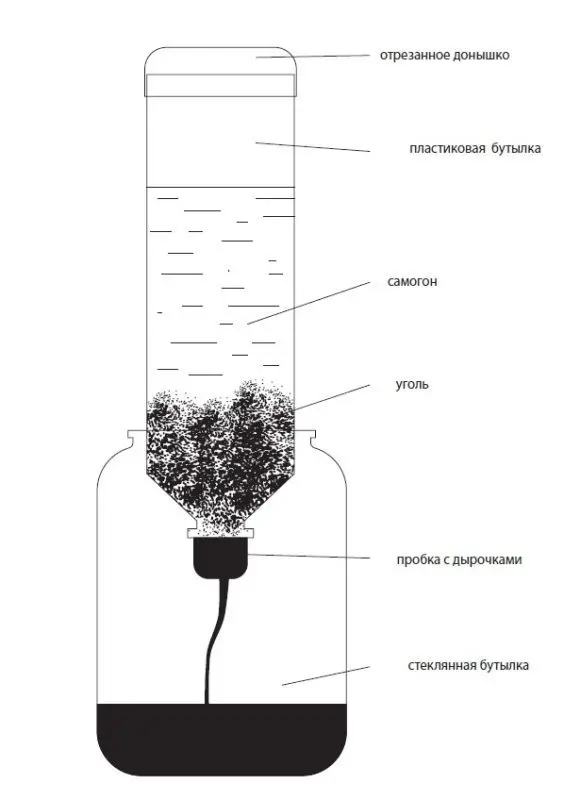Contents
Beginning moonshiners filter their product by adding some coal to a jar of moonshine (infusion method). Their more advanced colleagues know that flow cleaning works better, but requires a special tool – a carbon column. The cost of factory devices is high, but you can make something similar at home from improvised means: a plastic bottle, coal, a glass jar and cotton wool. The proposed technology combines two filtration methods – flow and infusion, which guarantees a high degree of purification.
1. Coal preparation
To clean moonshine, you need birch or coconut charcoal without impurities. The BAU-A and BAU-LV brands are ideal – activated birch charcoal, designed specifically for the alcoholic beverage industry. These stamps are sold over the Internet, it is not a problem to buy them.
Charcoal for barbecues, from aquarium and household filters for water purification, wood activated carbon from a pharmacy is also suitable. Pharmaceutical coal is the worst option, since it almost always contains third-party substances – talc and starch.
Activated carbon should not contain any other impurities, otherwise the filtration will negatively affect the quality of moonshine!
Often, coal is sold in lumps, which is not very good for cleaning moonshine. The larger the contact area, the better the filtration. First, the coal must be crushed with a hammer, after putting the pieces in a bag, for example, from under sugar. The grind should be as fine as possible. Grinding is best done on the street so that the coal dust that appears does not pollute the room.
After crushing, the coal is sieved through a colander or a sieve with large cells. Three fractions will be obtained: powder, small and large pieces that are not completely broken, which are returned back to the bag. Only small pieces and powder are used for filtration.
2. Manufacture of the carbon column
The most affordable vessel of the desired length and diameter is a plastic bottle. The bottom of a two or three-liter bottle is cut off, then 5-6 holes are drilled (burned) in it at an equal distance from each other. The bottom is needed to press the coal to the bottom, otherwise it will float all over the bottle. One hole of large diameter is drilled in the lid, through which the filtered moonshine will drain.
With prolonged contact with alcohol, plastic emits harmful substances, therefore, instead of a bottle, it is better to use another container – a glass jar or a metal cylinder, the design principle does not change. Filtration does not last long and is therefore safe, but in no case do not store vodka (alcohol, moonshine) in a plastic container.
3. Construction assembly
At the bottom is a two or three-liter glass jar into which purified moonshine flows. The cap is screwed on the neck of the bottle, the bottle itself is lowered into the jar upside down.
From above, pieces of coal are poured into the bottle – a little more than a third of a two-liter bottle in height, and covered with a bottom. If you pour a little coal, the filtration efficiency will drop, more – the coal will absorb some of the alcohol, the product will turn out to be of high quality, but the strength will drop by a couple of degrees.

4. Filtering
The entire remaining volume of the bottle is poured with moonshine to create sufficient pressure. Moonshine passes through the coal column and gets into the jar. At the exit it is black due to particles of coal dust, this is normal, the color is removed in the next step.
Gradually, the opening of the cover becomes clogged with coal dust, which reduces the jet. If the hole is completely clogged, the bottle is shaken and lightly squeezed a couple of times. In extreme cases, unscrew the lid and clean it by holding the neck opening with your finger.
Moonshine is run through this homemade carbon filter 2-3 times. Then coal powder is poured into it at the rate of 30-50 grams per liter, mixed, hermetically sealed and left for 1-2 days. Having absorbed the maximum possible amount of harmful impurities, coal settles to the bottom of the can. This is a sign of readiness for cleaning.
5. Cleaning
Makes moonshine transparent. The bottle, which was the basis of the carbon column, is washed away from dust particles. The neck is filled with cotton wool and twisted with a lid. The assembled structure is inserted into a glass jar. The column is filled with cloudy moonshine. It is advisable to cover the bottle with something on top so that the alcohol does not evaporate.

Pure moonshine flows into a jar. But after a while, the cotton filter will clog. In this case, the unfiltered moonshine is poured back into the jar (from which it was taken), the cotton wool is changed, the column is assembled and the tank is refilled with untreated moonshine. Cotton wool is replaced several times. Immediately after cleaning, moonshine is ready for use.









